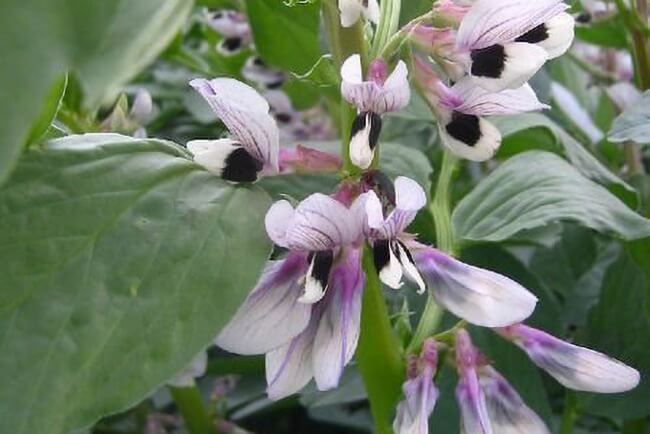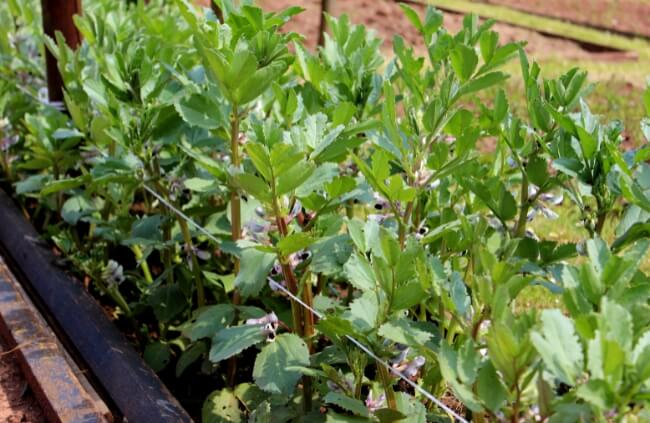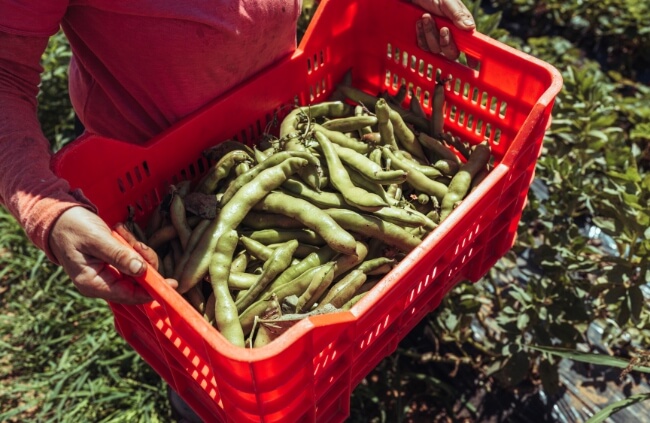Broad beans are easy to grow, although most varieties are best suited to cooler climates in Australia. They are one of my favourite veggies. Not only are these delicious and bountiful legumes, but they are also good for soil improvement.
Plant nitrogen greedy tomatoes after the winter broad bean harvest and watch them thrive! You will need a bit of space in your garden to grow broad beans, but it is definitely worth allocating some of your veggie patch to these fantastic vegetables.
Growing broad beans is simple, they put on a pretty flower display and then produce an abundance of tasty beans. Yum! This gardening guide outlines the process of planting broad bean seeds, how to grow and care for the plant, and when to harvest the pods.
More...
Botanical name: | Vicia faba |
|---|---|
Botanical family: | Fabaceae (Legume family) |
Getting to Know Broad Beans

Vicia faba is also known by the common names broad bean, fava beans, faba bean or field bean. It belongs to the Fabaceae family similar to soybeans. Broad beans are a favourite crop grown in backyard veggie gardens around the world and is one of the oldest foods recorded in history.
Growing broad beans is sometimes done as a cover crop given its use as a soil improver. They are tall leafy plants that can grow to almost 2 m tall. Fava beans are an excellent source of protein, fibre and vitamins A and B. They provide vibrant colour and flavour to any meal and are a staple in many cuisines.
Broad beans are best suited to mild temperate and cool climates in Australia, although some varieties can do well in warmer regions. If growing broad beans in subtropical or tropical parts of the country, you risk the chance of a short winter and not enough colder weather to get a good crop.
The good news for those growing broad beans is that they are hardy and frost tolerant plants.
The Best Soil for Broad Beans
Broad beans thrive in well-drained, relatively fertile, and slightly acidic soil. You don’t want the soil to become waterlogged. Like other beans, they will need higher amounts of phosphorus and potassium than nitrogen.
Prepare the soil well ahead of planting. It is recommended that you add compost or cow manure to the soil. Avoid using any fertilisers or manures that are high in nitrogen when growing broad beans.
You might also want to add an application of potash to your soil a couple of weeks before planting.
Broad Bean Flowers

Growing broad beans isn’t just about food production. You also get to enjoy some nice flowers along the way. Broad bean plants produce white and black flowers in late winter and early spring. These pretty flowers are 1-2 cm in size with five petals.
Bees and other beneficial insects are attracted to their pollen. The flowers are also edible for humans if that takes your fancy.
How to Grow Broad Beans in Australia
It is important not to overfeed the broad bean plants with nitrogen. Extra fertiliser and manure are usually unnecessary while the crop is growing. Too much nitrogen will promote leaf growth at the expense of flowers and pods. It can also result in disease. At most apply a low-nitrogen fertiliser once during the growing season, before flowering.
When the plants are young, they will be self-supporting. However, as they grow taller, they will need help staying upright. They tend to flop over when the pods develop and the plants become top-heavy.


Get Your Free Guide:
Master Growing Australian Natives eBook
A Must Have Complete Guide for Every Australian Garden
Get Your Free Guide:
Master Growing Australian Natives eBook
A Must Have Complete Guide for Every Australian Garden
There is no need to stake each plant individually. Support growing broad bean plants with string, garden twine or wire stretched between stakes at either end of the row. As noted above, planting in double rows will also help.
Water your broad beans about 2-3 times a week for the first month, after they have germinated. As the plants mature you can cut back watering to once a week, depending on the weather and rainfall. When the plant is flowering and producing broad bean pods you may need to up the watering frequency again.
To help with soil moisture levels and to maintain a consistent soil temperature it is a good idea to keep the soil around the plants well mulched. Use pea straw, sugar cane or lucerne hay to a depth of about 5 cm.

Growing Broad Beans from Seeds
Growing broad beans from seed is an easy and rewarding process. You should sow broad bean seeds directly into your veggie patch. Fava beans should be sown from early autumn to late winter. They need cooler weather to grow successfully so time your seed planting accordingly.
Cool areas of Australia have the greatest flexibility as to when to plant and grow broad beans. You can sow broad bean seeds from February to September. In temperate zones, you can sow seeds from March to June.
While harder to grow, in subtropical and tropical regions, you can plant seeds from March to May. In these parts of Australia you just have a much shorter window of opportunity to plant and grow broad beans.
Broad bean seeds will benefit from being soaked overnight prior to planting. Consider adding some Epsom Salts to the water which can help speed up germination.
Growing broad beans need plenty of space, so sow seeds at least 20-30 cm apart in double rows, with each pair of double rows spaced approximately 80 cm apart. Given broad beans are tall plants, planting in double rows will allow the plants to lean on each other for support, especially when they become top-heavy with pods.
It is worth thinking about staggering your planting to ensure a continuous harvest of fava beans. This way you can also stagger the subsequent planting of your tomato seedlings. Sow the seeds into the soil at the bottom of a furrow about 5 cm deep. Cover with soil. You will then need to water in well.
After that, resist watering again until the broad bean seeds have germinated, and you see a couple of open leaves. This usually takes about 2 weeks. Watering prematurely can cause germination to fail and the seeds to rot.
Where to Position Broad Beans in Your Garden
The best spot for growing broad beans in your garden is an open, sunny position. They are tall plants and can easily fall over in windy conditions so ensure they have some shelter and support.
As noted above, you will need to ensure you have allocated enough area for spaced planting. While broad beans can be grown in large pots they prefer to be planted in an in-ground veggie patch.
It is also worth thinking about where you are going to grow your tomato crop next season. Broad beans produce their own nitrogen and prepare the soil beautifully for tomato plants. Growing broad beans benefits your garden soil and veggie production all year round!
When to Harvest Broad Beans

Broad beans should be ready to harvest in spring and early summer. Depending on the time of planting and the climate you should expect to be picking broad beans around November. It typically takes 18-20 weeks from planting before the pods are ready to be picked.
We think broad beans taste best if harvested when they are young. They can be eaten like French green beans or snow peas. The later you harvest broad beans, the larger the pods, the harder the beans and stronger the flavour.
You will need to shell the pods and remove the individual beans. These half-ripe seeds can then be eaten. Don’t wait until the seeds become hard. These are best eaten a few days after harvesting.
Growing broad beans is a high reward exercise as each plant yields a good amount of food. A 5-6m double row of broad beans in your veggie patch should provide a good harvest for the average-sized family.
Broad Beans as Green Manure
Broad beans return valuable nitrogen to the soil. This is a resource not to be wasted and a key benefit of growing broad beans. After harvesting, you should consider either digging the plants into the soil or adding them to the compost.
Some people grow broad beans specifically to improve the soil. If this is your intention and you aren’t interested in the crop itself, cut the plants into the soil before the pods start to form.
Broad beans can be followed up in the veggie patch by leafy crops like brassicas (e.g. broccoli, cabbage, cauliflower) and plants like tomatoes, which have a high demand for nitrogen. Planting this way will mean fewer additives and additional feeds are needed in the soil.
If you have any questions about how to grow broad beans, get in touch.
Wrapping Up Our Guide to Growing Broad Beans in Australia
Growing broad beans is fun and rewarding. The plants are easy to grow, look good, and are highly productive. Fava beans can be eaten raw or cooked depending on when they are harvested.
As well as tasting good, broad beans enrich the soil with nitrogen when growing and if integrated back into the soil as green manure. Growing broad beans is a must for any gardener and they are a worthwhile addition to any Aussie backyard veggie patch.
Published on August 22, 2023 by Maisie Blevins
Last Updated on February 5, 2025





Hi
Thanks for the information on broadbeans. When they’ve finished fruiting, would you recommend cutting them off close to the ground and leaving the roots in? I’m thinking it might be beneficial in terms of nitrogen fixing and soil stabilisation.
I appreciate your advice.
Kay
Hi Kay,
Great question. They work basically like field beans in that the entire plant can be chopped up small and dug right back into the soil as a green manure. They are quite nitrogen hungry, so the more plants you can retain (either directly in the soil, or as compost) the better.
In practice, it’s sometimes not practical to put the whole plant back into the soil after broad beans have finished fruiting, so what we do every year is exactly what you suggested – cut the plant right back to the ground and leave the roots to rot back when they’ve finished. The top growth, we cut up as small as possible and add to the compost pile.
It just depends on what you want to do with that patch of earth after broad beans because they usually finish pretty early in the season, and it’s good to have the soil in that bed ready as soon as possible to plant something else.
Best regards,
Gary Clarke
Aussie Green Thumb
Hi Maisie
What would you suggest I grow with/amongst broad beans instead it being a mono crop
Thks Mary Anne
Hey Mary Anne,
Great question, I have my broad beans growing at the back of my raised garden bed with has a metal trellis so it will grow next to, so if needed i can tie them on. In front I am growing some dwarf broccoli about 50cm away so plenty of room for both.
Plants that you can grow around your broad beans would be lettuces, carrots, marigolds, parsley and dwarf kales. I would try to avoid plants that are going to grow too big and take space needed by the broad beans.
If I weren’t growing so much lettuce elsewhere I would plant lettuces in between my broad beans.
What are you thinking of growing?
Cheers,
Maisie